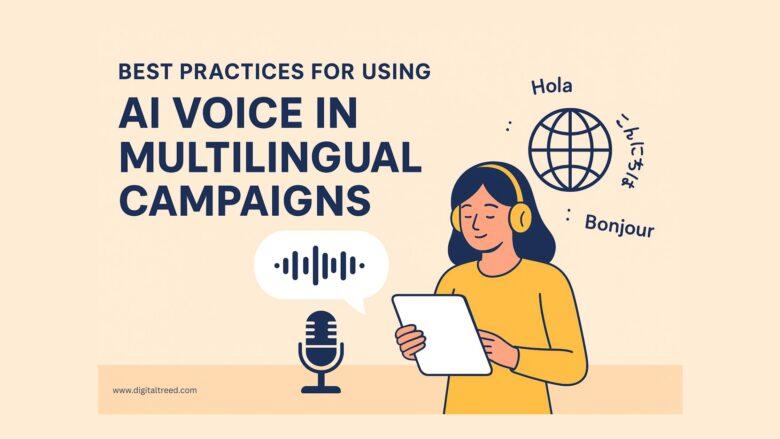Are you thinking of expanding your brand’s message to a global audience? Successfully completing this task is no mean feat. This task is multifaceted and demands more than the mere translation of words. Thankfully, unbelievable strides in AI voice technology makes it possible for organizations of all sizes to quickly send across their message in multiple languages without hiring voice actors or spending thousands in renting a studio. However, the true power of this technology is unlocked when you are aware of the best practices of using it to elevate your multilingual campaigns.
So, what are you still waiting for? Scroll down to know the best practices for using AI voice in your multilingual campaigns.
Best Practice 1: Transcend Translation with Localization
The first and most essential best practice is comprehending what translation and localization are. Therefore, when translating a script using AI voice tools, ensure you keep in mind the cultural relevance.
For example, a product script in the U.S. could be casual and energetic, while a native campaign for promoting a product or service in Japan could necessitate using a more respectful and formal tone to fit cultural expectations.
It is important to keep in mind such cultural nuances when translating your campaign script or using multilingual voiceover.
Modern AI voice platforms, such as Murf AI, let you choose from 200+ realistic voices and 10+ speaking styles, delivering a natural-sounding tone with complete control over tone, pitch, speed, pronunciation, and even intonation.
Best Practice 2: Prepare Your Script for AI Optimization
For the best outcomes, you can’t just copy and paste a script into an AI voice generator. You need to fine-tune your words to take maximum advantage of the technology. This practice makes for a smooth, natural-sounding voiceover that sounds human, not computer-generated. Here’s what to do:
- Refine your script with a human touch: While AI generates the voice, the script itself is the foundation. Use simple, clear language and avoid overly long or complex sentences. Break down your script into logical sections to guide the AI’s delivery.
- Apply punctuation strategically: The AI applies punctuation to decide on pauses, quotes, and emphasis. Utilize commas for a bit of a pause, periods for a complete stop, and question marks for a rising intonation. This generalizes the AI to read the text with the right cadence and feeling.
- Add phonetic spellings: If brand names, technical jargon, or proper nouns that may be incorrectly pronounced by the AI exist in your script, you can usually add phonetic spellings in brackets. This is an important step to ensure accuracy and consistency in all your voiceovers. If your brand name happens to be tricky to pronounce, providing the AI with a phonetic guide makes it sound right every time.

Best Practice 3: Take Advantage of Platform Features for Auditory Cohesion
The first best practice is to utilize all the features available on AI voice platforms to make your multilingual campaigns cohesive and professional. A voice can be more than a translated recording; it can be an extension of your brand’s auditory identity.
- Alter voice pitch and emotion: Most platforms provide detailed control over a voice’s pitch, tone, and emotional rendering. You can pitch a voice to sound relaxed, enthusiastic, serious, or welcoming. This enables you to harmonize the mood of the voiceover with your campaign’s content, whether it’s an energetic advertisement or a grave public service announcement.
- Control over speaking speed: Speeding up or slowing down the voice is a necessary function to fit voiceovers into video clips or presentations of a given length. Such a feature provides full control over the speed of your content, ensuring that it matches the visual content.
- Develop a consistent brand voice: Most sophisticated AI voice platforms enable you to develop a “brand voice” that can be deployed across various languages. Your brand’s audio identity is thus consistent globally, engendering familiarity and trust among a worldwide audience.
Best Practice 4: A/B Test and Iterate
The flexibility of AI voice tech means that it’s possible to experiment in ways not possible with traditional voiceover production. One key best practice is using that flexibility for data-driven decision-making. ● Test various voice profiles: Conduct a small-scale A/B test in a new market using two varied AI voice profiles. For instance, compare a younger, relaxed voice to a more mature, authoritative voice. You can measure engagement and conversions immediately to see which voice works best with that particular audience.
- Tune by performance data: If your campaign isn’t doing as well as you anticipated within a specific region, review the data to determine if the voice or tone is the problem. With AI, you can create a new voiceover with a new style in minutes, enabling you to get a new version out quickly and keep optimizing your campaign.
- Generate dynamic content: The capability to produce new voice-overs in real-time means that dynamic content is possible. You can change product descriptions, promotions, or news announcements in different languages as soon as you get new information, ensuring your content is always fresh and up to the moment.
Conclusion
Artificial intelligence voice technology has leveled the global marketing playing field, and any organization can now target global markets with speed and ease. Following these best practices, you can advance beyond basic translation and produce multilingual campaigns not just accurate but also relevant to the culture, emotionally powerful, and precisely on brand.

Leave a Reply